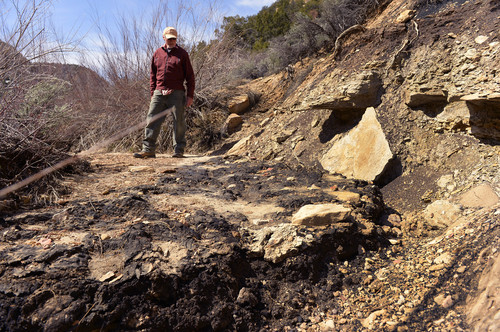This is an archived article that was published on sltrib.com in 2014, and information in the article may be outdated. It is provided only for personal research purposes and may not be reprinted.
A "pinhole" leak that went undetected for weeks, possibly months, is responsible for the oil now matting a desert wash in the Grand Staircase-Escalante National Monument, according to officials probing the spill discovered last month.
Bureau of Land Management officials are figuring out how to monitor and contain the mess, but they say leaving the oil in place will likely pose the least threat to the fragile desert ecosystems at the headwaters of the Escalante River.
The Upper Valley oil field, developed in the 1960s and '70s, sits on a remote mesa along the monument's northern edge, west of Escalante, the tiny historic ranching town that gives this scenic region its name.
The field's aging network of 3-inch gathering lines has been implicated in at least three serious petroleum releases in as many years, most recently the spill in Little Valley Wash first reported by hikers three weeks ago.
The field's operator, Houston-based Citation Oil and Gas Corp., failed to report these spills as required under the permit and operating plan that allow it to extract oil and gas from public lands.
But federal officials believe there may be extenuating circumstances and say the company has cooperated fully in efforts to determine the causes and address the environmental damage.
Acting monument supervisor Sarah Schlanger says the Little Valley release could have been so gradual that it failed to trigger Citation's leak-detection equipment, which monitors pressure changes inside pipelines. The company discovered the leak and patched the pipe sometime last winter, but the oil had moved down the wash so the extent of the spill was not immediately obvious.
Citation's operating plan required the company to report leaks greater than 10 gallons, but it may not have known it exceeded the threshold because the rugged terrain below was still covered in snow, BLM officials said.
Schlanger has since ordered the company to report all future leaks, regardless of size, within 24 hours of their discovery. The U.S. Forest Service has also instructed the company to beef up its reporting, after leaks associated with Upper Valley wells on the Dixie National Forest lands adjacent to the monument.
Citation regional supervisor Mark Bing did not respond to email and voice-mail messages Wednesday.
The latest spill came from a pipe moving hot liquids from Citation's Well No. 27, which yields only 17 barrels of oil a day, plus another 400 barrels of saline water.
The pipeline, which runs under a road to the well, leaked from a spot about 200 yards up-gradient from the well. The escaped water-oil mix dropped down a steep gully and the oil accumulated in the wash, leaving a tarry carpet up to six inches deep stretching 1.5 miles downstream.
The spill has fueled environmentalists' arguments that the BLM should not allow oil and gas development near parks and other sensitive areas and must apply stricter standards to existing development.
It has also caught the attention of Interior Secretary Sally Jewell, who noted that it is difficult for the BLM to know what happens on every section of the 245 million acres it administers.
"It's a good illustration that these are vast landscapes," Jewell said. "We rely on operators doing a good job and reporting issues when they occur, and there's probably some lessons to be learned on this one."
Upon receiving photos of the spill, the BLM dispatched teams of petroleum engineers, geologists and biologists to the site.
Their reports deflated initial speculation that the oil had spilled decades ago.
However, there is anecdotal evidence that the field discharged oil in several areas back in the 1970s, long before the monument's 1996 designation, when environmental standards were far more lax. Back then, crews simply mixed oil with dirt, and vestiges of those spills may still be apparent, said monument spokesman Larry Crutchfield.
But the stuff clogging the wash is no more than a few years old and monument officials are determining what kind of threat it poses to plants, wildlife and water. The BLM is also examining neighboring drainages for oil contamination.
"We have crews doing assessment of the chemical composition of the oil, looking for saline indicators in the soil that would go along with spills and collecting soil samples," Schlanger said. "That helps us get a handle on the relative age of any spills and get a handle on the sequence of events and potential of the oil to harm any resources out there."
The salt in the water produced by the well would have been expected to damage plants along the wash, but so far there is little evidence that the plants — such as yellow fir needles — are suffering or that salinity has built up in the soils.
But it is still too early in the spring for many species to sprout leaves, so BLM botanists will closely monitor rabbit brush, oak brush and grasses through June.
The oil residues pose a challenging conundrum, Schlanger said.
"We are pretty lucky. The bulk of the spill is settled and making these deposits in the drainage floor. As long as they remain intact, it's not moving," she said. "If we start digging it up, that will make it more likely to move. We would be breaking it up into small pieces and moving it."
Over time, the oil will biodegrade, but currently bits of oil and tar balls litter the wash.
"Our goal is to make sure that any oil that could harm water doesn't keep moving down the wash," Schlanger said. Little Valley Wash flows into Alvey Wash, which arcs through the Escalante Valley and its flow eventually reaches Lake Powell.







